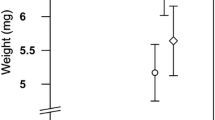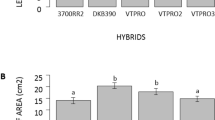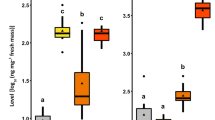Abstract
Plants attacked by herbivores have evolved different strategies that fend off their enemies. Insect eggs deposited on leaves have been shown to inhibit further oviposition through visual or chemical cues. In some plant species, the volatile methyl salicylate (MeSA) repels gravid insects but whether it plays the same role in the model species Arabidopsis thaliana is currently unknown. Here we showed that Pieris brassicae butterflies laid fewer eggs on Arabidopsis plants that were next to a MeSA dispenser or on plants with constitutively high MeSA emission than on control plants. Surprisingly, the MeSA biosynthesis mutant bsmt1-1 treated with egg extract was still repellent to butterflies when compared to untreated bsmt1-1. Moreover, the expression of BSMT1 was not enhanced by egg extract treatment but was induced by herbivory. Altogether, these results provide evidence that the deterring activity of eggs on gravid butterflies is independent of MeSA emission in Arabidopsis, and that MeSA might rather serve as a deterrent in plants challenged by feeding larvae.


Similar content being viewed by others
References
Agrawal AA, Janssen A, Bruin J, Posthumus MA, Sabelis MW (2002) An ecological cost of plant defence:attractiveness of bitter cucumber plants to natural enemies of herbivores. Ecol Lett 5:377–385
Ament K, Kant MR, Sabelis MW, Haring MA, Schuurink RC (2004) Jasmonic acid is a key regulator of spider mite-induced volatile terpenoid and methyl salicylate emission in tomato. Plant Physiol 135:2025–2037
Attaran E, Zeier TE, Griebel T, Zeier J (2009) Methyl salicylate production and jasmonate signaling are not essential for systemic acquired resistance in Arabidopsis. Plant Cell 21:954–971
Bergström G, Rothschild M, Groth I, Crighton C (1994) Oviposition by butterflies on young leaves: investigation of leaf volatiles. Chemoecology 5–6:147–158
Blaakmeer A, Hagenbeek D, Vanbeek T, De Groot A, Schoonhoven L, van Loon JJA (1994a) Plant response to eggs vs. host marking pheromone as factors inhibiting oviposition by Pieris brassicae. J Chem Ecol 20:1657–1665
Blaakmeer A, Stork A, Vanveldhuizen A, Vanbeek T, De Groot A, van Loon JJA, Schoonhoven L (1994b) Isolation, identification, and synthesis of miriamides, new hostmarkers from eggs of Pieris brassicae. J Nat Prod 57:90–99
Bolter CJ, Dicke M, vanLoon J, Visser JH, Posthumus MA (1997) Attraction of Colorado potato beetle to herbivore-damaged plants during herbivory and after its termination. J Chem Ecol 23:1003–1023
Bruessow F, Gouhier-Darimont C, Buchala A, Metraux J-P, Reymond P (2010) Insect eggs suppress plant defence against chewing herbivores. Plant J 62:876–885
Chen F, D’Auria JC, Tholl D, Ross J, Gershenzon J, Noel J, Pichersky E (2003) An Arabidopsis thaliana gene for methylsalicylate biosynthesis, identified by a biochemical genomics approach, has a role in defense. Plant J 36:577–588
de Vos M, Kriksunov KL, Jander G (2008) Indole-3-acetonitrile production from indole glucosinolates deters oviposition by Pieris rapae. Plant Physiol 146:916–926
Dicke M, Baldwin IT (2010) The evolutionary context for herbivore-induced plant volatiles: beyond the “cry for help”. Trends Plant Sci 15:167–175
Gouhier-Darimont C, Schmiesing A, Bonnet C, Lassueur S, Reymond P (2013) Signalling of Arabidopsis thaliana response to Pieris brassicae eggs shares similarities with PAMP-triggered immunity. J Exp Bot 64:665–674
Gripenberg S, Mayhew PJ, Parnell M, Roslin T (2010) A meta-analysis of preference-performance relationships in phytophagous insects. Ecol Lett 13:383–393
Halkier BA, Gershenzon J (2006) Biology and biochemistry of glucosinolates. Annu Rev Plant Biol 57:303–333
Hilker M, Meiners T (2011) Plants and insect eggs: how do they affect each other? Phytochemistry 72:1612–1623
Hopkins RJ, van Dam NM, van Loon JJA (2009) Role of glucosinolates in insect-plant relationships and multitrophic interactions. Annu Rev Entomol 54:57–83
Howe GA, Jander G (2008) Plant immunity to insect herbivores. Annu Rev Plant Biol 59:41–66
Huang X, Renwick JA (1994) Relative activities of glucosinolates as oviposition stimulants for Pieris rapae and P. napi oleracea. J Chem Ecol 20:1025–1037
Kessler A, Baldwin IT (2001) Defensive function of herbivore-induced plant volatile emissions in nature. Science 291:2141–2144
Koo YJ, Kim MA, Kim EH, Song JT, Jung C, Moon J-K, Kim J-H, Seo HS, Song SI, Kim J-K et al (2007) Overexpression of salicylic acid carboxyl methyltransferase reduces salicylic acid-mediated pathogen resistance in Arabidopsis thaliana. Plant Mol Biol 64:1–15
Koschier EH, Hoffmann D, Riefler J (2007) Influence of salicylaldehyde and methyl salicylate on post-landing behaviour of Frankliniella occidentalis Pergande. J Appl Entomol 131:362–367
Little D, Gouhier-Darimont C, Bruessow F, Reymond P (2007) Oviposition by pierid butterflies triggers defense responses in Arabidopsis. Plant Physiol 143:784–800
Mallinger RE, Hogg DB, Gratton C (2011) Methyl salicylate attracts natural enemies and reduces populations of soybean aphids (Hemiptera: Aphididae) in soybean agroecosystems. J Econ Entomol 104:115–124
Mithöfer A, Boland W (2012) Plant defense against herbivores: chemical aspects. Annu Rev Plant Biol 63:431–450
Peñaflor MFGV, Erb M, Miranda LA, Werneburg AG, Bento JMS (2011) Herbivore-induced plant volatiles can serve as host location cues for a generalist and a specialist egg parasitoid. J Chem Ecol 37:1304–1313
Renwick J, Chew FS (1994) Oviposition behavior in Lepidoptera. Annu Rev Entomol 39:377–400
Reymond P (2013) Perception, signaling and molecular basis of oviposition-mediated plant responses. Planta 238:247–258
Reymond P, Weber H, Damond M, Farmer EE (2000) Differential gene expression in response to mechanical wounding and insect feeding in Arabidopsis. Plant Cell 12:707–720
Reymond P, Bodenhausen N, Van Poecke RMP, Krishnamurthy V, Dicke M, Farmer EE (2004) A conserved transcript pattern in response to a specialist and a generalist herbivore. Plant Cell 16:3132–3147
Rodriguez-Saona C, Crafts-Brandner SJ, Paré PW, Henneberry TJ (2001) Exogenous methyl jasmonate induces volatile emissions in cotton plants. J Chem Ecol 27:679–695
Rothschild M, Schoonhoven L (1977) Assessment of egg load by Pieris brassicae (Lepidoptera: Pieridae). Nature 266:352–355
Schoonhoven LM, Sparnaay T, van Wissen W, Meerman J (1981) Seven-week persistence of an oviposition-deterrent pheromone. J Chem Ecol 7:583–588
Schweizer F, Fernández-Calvo P, Zander M, Diez-Diaz M, Fonseca S, Glauser G, Lewsey MG, Ecker JR, Solano R, Reymond P (2013) Arabidopsis basic helix-loop-helix transcription factors MYC2, MYC3, and MYC4 regulate glucosinolate biosynthesis, insect performance, and feeding behavior. Plant Cell 25:3117–3132
Shapiro AM (1981) Egg-mimics of Streptanthus (Cruciferae) deter oviposition by Pieris sisymbrii (Lepidoptera: Pieridae). Oecologia 48:142–143
Snoeren TAL, Kappers IF, Broekgaarden C, Mumm R, Dicke M, Bouwmeester HJ (2010a) Natural variation in herbivore-induced volatiles in Arabidopsis thaliana. J Exp Bot 61:3041–3056
Snoeren TAL, Mumm R, Poelman EH, Yang Y, Pichersky E, Dicke M (2010b) The herbivore-induced plant volatile methyl salicylate negatively affects attraction of the parasitoid Diadegma semiclausum. J Chem Ecol 36:479–489
Turlings T, Bernasconi M, Bertossa R, Bigler F, Caloz G, Dorn S (1998) The induction of volatile emissions in maize by three herbivore species with different feeding habits: possible consequences for their natural enemies. Biol Control 11:122–129
Ulland S, Ian E, Mozuraitis R, Borg-Karlson A-K, Meadow R, Mustaparta H (2008) Methyl salicylate, identified as primary odorant of a specific receptor neuron type, inhibits oviposition by the moth Mamestra brassicae L. (Lepidoptera, Noctuidae). Chem Senses 33:35–46
Van Poecke RMP, Posthumus MA, Dicke M (2001) Herbivore-induced volatile production by Arabidopsis thaliana leads to attraction of the parasitoid Cotesia rubecula: chemical, behavioral, and gene-expression analysis. J Chem Ecol 27:1911–1928
Williams L, Blackmer JL, Rodriguez-Saona C, Zhu S (2010) Plant volatiles influence electrophysiological and behavioral responses of Lygus hesperus. J Chem Ecol 36:467–478
Wu J, Baldwin IT (2010) New insights into plant responses to the attack from insect herbivores. Annu Rev Genet 44:1–24
Zhao N, Guan J, Ferrer J-L, Engle N, Chern M, Ronald P, Tschaplinski TJ, Chen F (2010) Biosynthesis and emission of insect-induced methyl salicylate and methyl benzoate from rice. Plant Physiol Biochem 48:279–287
Zheng S-J, Snoeren TAL, Hogewoning SW, van Loon JJA, Dicke M (2010) Disruption of plant carotenoid biosynthesis through virus-induced gene silencing affects oviposition behaviour of the butterfly Pieris rapae. New Phytol 186:733–745
Zheng X-Y, Spivey NW, Zeng W, Liu P-P, Fu ZQ, Klessig DF, He SY, Dong X (2012) Coronatine promotes Pseudomonas syringae virulence in plants by activating a signaling cascade that inhibits salicylic acid accumulation. Cell Host Microbe 11:587–596
Acknowledgments
We thank Blaise Tissot for taking care of the plants. This work was supported by the Swiss National Science Foundation Grant 31003A_149286 and EUROCORES programme EuroVOL to P. R.
Author information
Authors and Affiliations
Corresponding author
Electronic supplementary material
Below is the link to the electronic supplementary material.
ESM 1
(PDF 5431 kb)
Rights and permissions
About this article
Cite this article
Groux, R., Hilfiker, O., Gouhier-Darimont, C. et al. Role of Methyl Salicylate on Oviposition Deterrence in Arabidopsis thaliana . J Chem Ecol 40, 754–759 (2014). https://doi.org/10.1007/s10886-014-0470-9
Received:
Revised:
Accepted:
Published:
Issue Date:
DOI: https://doi.org/10.1007/s10886-014-0470-9




